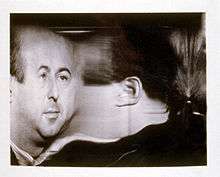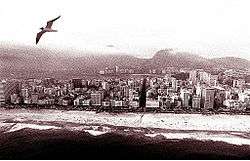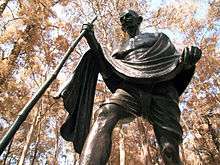Sérgio Valle Duarte
| Sergio Valle Duarte | |
|---|---|
 London 1976 | |
| Born |
September 26, 1954 São Paulo (São Paulo) Brazil |
| Nationality | Brazilian |
| Known for | Multimedia, photography, electrophotography |
| Movement | Contemporary art, BioArt |
Sergio Valle Duarte (born September 26, 1954), also known as Sergio Duarte, is a Brazilian multimedia artist and photographer.
Biography
Self-taught, he lives and works in Sao Paulo.[1] Between 1972 and 1974, he worked as an actor in television advertisements for Campari and Nestle.
Due to the military dictatorship in Brazil, in 1976 he moved to London where he worked as assistant to Rex Features International Photographic Press Agency.
As freelance photographer, he followed the pop music groups[2] The Who, Tangerine Dream, Genesis, Deep Purple, ZZ Top. In 1977 Brazilian magazine Geração Pop (Editora Abril) features a series of pictures he captured in London of The Rolling Stones. Soon after, between Europe and South America, he collaborates with a range of magazines, Interview, Playboy, Vogue, Sony Style, (1978– 1990). Within those years he joins The Image Bank, Getty Images (1980 - 2005) and he is featured in photography art magazines[3] Collector's Photography U.S.A., Zoom France, Zoom Italy, Newlook France, Newlook U. S. A., Newlook.
As Multimedia artist, since 1970, participated in the visionary exhibition "New Media Art Multimedia 70/80" with the triptych Video Oil at Armando Alvares Penteado Foundation, curatorial Deysi Piccinini and the exhibition " The plot of Taste " another look at the daily, at the Julio Plaza installation " Electronic Amusement " with the project " Video Hypnosis " at the Biennial Foundation, São Paulo, 1987. Duarte evolved his work adding new technologies and techniques with digital images, electrophotography, Xerox art[4] conceptualizing artistically the reading of DNA and also in the future, the writing of DNA. To his portraits he sewings strands of hair of the models to allow them a future cloning.[5]
The model Gianne Albertoni is a part of the series that is featured in the permanent collection of museums in Europe and South America. The series is denominated by the artist as "Eletrografias e Fotografias com Fios de Cabelo para Futura Clonagem" (Electrophotographs and Photographs with Human Hair for Future Cloning), BioArt.[6][7]
Duarte is inspired by the surrealist tradition and the originality of his work resides in the fantastic colors and in the richness of details that he uses.[8] Irreverent, but never dramatic, with a playful irony, Duarte's works are constantly moving, dancing, flying, stretching, as if they are to expand out of the frame.[9]
During the 80s, he befriends the Italian artist and philosopher Joseph Pace, founder in Paris of Filtranisme, a neo-existential philosophical and artistic current, joining, in 1990, the enlarged "filtranistes" group.[10]
Due to a leak in the roof of the studio artist at Spring Street during a summer storm in the late nineties, much of the work was destroyed, it is rare to find analog works before this period.
He authenticates his works with a thumbprint.
Sergio Valle Duarte focuses his personal expression interpreting freely sacred and profane themes. From 2005 to 2015 he collaborates as curator for Brazil for the Florence Biennale and for the Padua Art Fair.

Collections
- Sao Paulo Museum of Modern Art,[11][12] (Brazil).
- Itaú Cultural,[13] Sao Paulo, (Brazil).
- Museum of Modern Art, Rio de Janeiro,[14] Rio de Janeiro, (Brazil).
- Museu de Arte Brasileira da Fundação Armando Alvares Penteado, Sao Paulo, (Brazil).
- Museum Afro Brasil, Sao Paulo, (Brazil).
- Yokohama City Museum,[15] Yokohama, (Japan).
- Musée Français de la Photographie, Bievres, (France).
- Musée de l'Élysée,[16] Lausanne, (Switzerland).
- Museum für Fotokopie,[17] Mülheim, (Germany).
- Auer Photo Foundation,[18] Geneva, (Switzerland).
- Collection Gilberto Chateaubriand, Museum of Modern Art, Rio de Janeiro, (Brazil).
- Privet Collection Roberto Bertani, Sao Paulo, (Brazil).
- Collection Joaquim Paiva, Museum of Modern Art, Rio de Janeiro", (Brasil).
- Museo de la Solidaridad Salvador Allende Santiago, (Chile).
- Museo Internacional de Electrografia, MIDE, Cuenca, (Spain).
- Centro Nacional de Investigación, Documentación e Información de Artes Plasticas Cidade do México, (México).
Gallery
-

A Bowing in Art 1996
-

Avenida Vieira Souto, Lagoa, Rio de Janeiro, Brazil 1985
-

Monumento as Bandeiras - Victor Brecheret, Parque do Ibirapuera, Sao Paulo, Brazil 2004
-
Tunel Ayrton Senna, Sao Paulo, Brazil 2004
-

A Luz Station with presence, Sao Paulo, Brazil 2004
-

Gandhi, Parque do Ibirapuera, Sao Paulo, Brazil by Gautam Pal, 2006
-

Auditorio Ibirapuera, salivating
-

Analog Aerial - Manhattan - Brooklyn Bridges, New York City 1980
Notes
- ↑ Duarte Sergio, Enciclopedia Itau Cultural
- ↑ Photographers encyclopedia international
- ↑ Photographers encyclopedia international
- ↑ Enciclopédia Itaú Cultural
- ↑ Enciclopédia Itaú Cultural
- ↑ Enciclopédia Itaú Cultural
- ↑ Photographers encyclopedia international
- ↑ Enciclopédia Itaú Cultural
- ↑ Enciclopédia Itaú Cultural
- ↑ Letizia Fanari E&A Art: Joseph Pace Filtranisme, 2007, p. 24/25, Roma, Italia
- ↑ Museu de Arte Moderna de Sao Paulo
- ↑ Enciclopédia Itaú Cultural
- ↑ Enciclopédia Itaú Cultural
- ↑ Photographers Encyclopedia International
- ↑ Photographers Encyclopedia International
- ↑ Photographers Encyclopedia International
- ↑ Auer Photo Foundation
- ↑ Auer Photo Foundation

Selected bibliography
- Arteder, Muestra Internacional de Obra Grafica, Bilbao, Catalogo, Mar 19, 1982 p. 154, 155, (Spain).
- Arlindo Machado, Sergio Valle Duarte, as fantásticas paisagens dos sonhos, Folha de Sao Paulo, 07 set. 1984, Ilustrada p. 38, (Brazil).
- Arlindo Machado, " Os fantasmas e a realidade", Folha de Sao Paulo, Mar 6, 1985, Fotografia Critica, p. 45, (Brazil).
- Robert Louit " Portifolio Revista Zoom Internacional", 1985, edição 121, p. 26,27,28,29,30,31, França.
- Daysi Peccinini – "Arte Meios Multimeios 70/80" FAAP – Projeto Video Oil,1985,(Brazil). ISBN 978-85-98864-47-1
- Renato Janine Ribeiro "Um televerão", Folha de Sao Paulo, 04 de maio. 1986, Folhetim p. 2, (Brazil).
- José Américo Motta Pessanha" Imagem do corpo nu", Catalogo Funarte 1986, p. 25, 27, (Brazil).
- Ana Maria Guariglia, " Em fotos, união exótica de rostos e flores", Folha de Sao Paulo, 03 fev. 1988, Informatica p. 12, (Brazil).
- Pepe Escobar " Reflexos de Sao Paulo em Amsterdã" O Estado de Sao Paulo, Jun 20, 1989, Caderno 2, p. 66, (Brazil).
- NRC Handelsblad, " Musea", 21 junho 1989, p. 6,(Netherlands).
- Sadahiro Suzuki "World Photographic Exhibition" Catalogo, 1989. p. 54, (Japan).
- Klaus Urbons " Kunst und design mit dem Fotokopierer", DuMont Buchverlag,Kolm 1991, p. 164, 165, image 38, (Germany). ISBN 3-7701-2655-6
- Reynaldo Roels Jr. "Arte Erótica", Catalog Museum of Modern Art, Rio de Janeiro, 1993, p. 15 Brasil.
- Klaus Urbons " Elektrografie analog und digitale bilder", DuMont Buchverlag Kolm, 1994, p. 136 image 37, (Germany). ISBN 3-7701-3203-3
- Paola Sammartano " Portifolio Revista Zoom Internacional" 1995, p. 62, 63, 64, 65, 66, 67, (Italy).
- Ivo Mesquita, Tadeu Chiarelli, Ricardo Mendes" FOTOGRAFIAS no acervo do Museu de Arte Moderna de Sao Paulo", 2002, p. 30, 31, (Brazil).
- Tadeu Chiarelli "Catalog geral do acervo do Museu de Arte Moderna de Sao Paulo", 2002, p. 85, 86, 87, 88, 89, (Brazil).
- Coleção Joaquim Paiva, "Visões e Alumbramentos" Museum of Modern Art, Rio de Janeiro", 2002, (Brazil).
- Eduardo Bueno "São Paulo 450 anos em 24 horas", Bueno e Bueno 2004, p. 21, 22, 23, 197, (Brazil).
- Florençe Biennale, "Catalog",2007, p. 748, (Italy).
- Emanuel Araujo " Esteticas, sueños utopias de los artistas de Brasil por la libertad", Imprensa Oficial 2010 p. 110, 124, (Brazil). ISBN 978-85-7060-816-1
- João j. Spinelli " Alex Vallauri Graffiti" Editora Bei, 2010 flap p. 176, 177, (Brazil). ISBN 978-85-7850-046-7
- Florence Biennale,"Catalog", 2011, p. 477,(Italy).
External links
- Enciclopédia Itaú Cultural de Arte e Cultura Brasileiras ISBN 978-85-7979-060-7
- Sao Paulo Museum of Modern Art
- Photographers Encyclopedia International
- Fundación Telefónica Espanha
.tif.jpg)